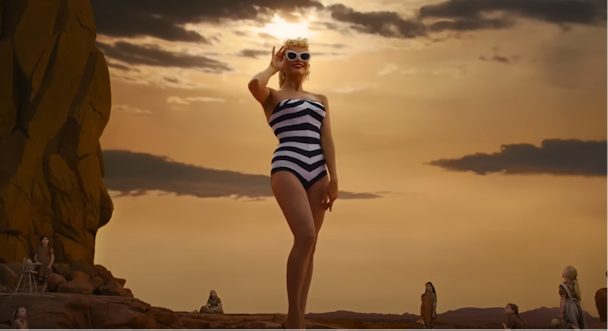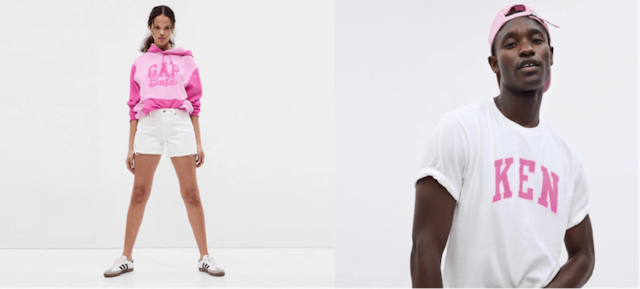Mattel brand chief on 5 ways Barbie changed its marketing model forever
Mattel executive vice-president and chief brand officer Lisa McKnight tells The Drum how Barbie’s success this year goes beyond box office figures and toy sales; it has totally reshaped its business. She’s one of five CMOs shortlisted for the WFA’s Global Marketer of the Year. Here, she reveals her secret formula.

Greta Gerwig’s Barbie raked in $1.4bn in global box office sales / Warner Bros
Five months after Barbie hit the big screen, Mattel’s executive vice-president and chief brand officer Lisa McKnight sits down with The Drum to reflect on the movie’s far-reaching impact.
“Barbie the movie has proved out our long-term strategy to evolve from a toy manufacturer to an IP-driven company,” she says. And with 14 more movies already in development and a long list of events in the works, plus a huge push into gaming being planned, it is clear that Barbie has given Mattel confidence to steer the 77-year-old behemoth in this new direction.
Greta Gerwig’s Barbie raked in $1.4bn in global box office sales to become the highest-grossing movie of the year. The movie also led to a 16% rise in Barbie toy sales in the third quarter of 2023. During its third-quarter earnings, chief executive officer Ynon Kreiz explained: “Our results benefited from the success of the Barbie movie, which became a global cultural phenomenon and marked a key milestone for Mattel.”
Advertisement
Kreiz, the former chief of Endemol Group, the world’s largest owner of independent TV production companies, wants to transition Mattel from a toy maker to an entertainment empire and Knight is on board with this strategy. “There’s naturally all sorts of business opportunities, experiences, content, storytelling and different categories of business outside of toys that can be unlocked,” she says.
Here are the five ways McKnight is now thinking differently about Mattel’s marketing model...
1. Think fans, not customers
An unexpected lesson from the movie, McKnight says, has been a shift to thinking about audiences and fans rather than consumers.
“We’ve always been very consumer-centric in the we think about our product development processes, but thinking about our consumer now as a fan is much broader. Fans then mean audience and thinking about audience size is a really interesting shift in how we are operating as business leaders and marketers.”
Barbie has over 5 million followers on social media and 12 million on YouTube. “There is a dialogue that’s happening with those fans, there’s engagement that ultimately strengthens brand love and affinity, which, when we serve up the right experience and the right product at the right time, will land conversion.”
Advertisement
This is a significant change in thinking for a business that has historically been obsessed with conversion metrics. “Some things that we do initially are about building engagement – it’s a long game.”
Mattel also partnered with over 100 brands, pushing Barbie into new categories from fashion (Gap, pictured), beauty (Truly Beauty and Revlon), lifestyle (Mumu) and homeware (Ruggable).

“We don’t need to be so narrow or think about one specific category or item. We have an incredible library of IP – we think we have probably the most valuable library in the industry – and we’ll be looking to unlock all sorts of experiences by thinking through a fan lens.”
2. Entertainment first
Properties such as Hot Wheels, Uno and Major Matt Mason, in collaboration with Tom Hanks, are all next in line to get the Barbie movie treatment. “This is the new way forward for Mattel – we had a strategy to unlock the value of IP, starting with Barbie, and we will now be applying this playbook to the rest of the Mattel portfolio.”
McKnight says the caliber of talent that worked on Barbie has “raised the bar in terms of the interest level in the Mattel portfolio.” It has also led its existing creative partners to “push their thinking,” McKnight reveals. For example, Mattel is now exploring a Magic 8 Ball-inspired thriller, which it wouldn’t have had the confidence to do before. “Its creators have seen how collaborative we are and how trusting we’ve been with our filmmaker partners,” she adds.
Suggested newsletters for you
McKnight manages over 100 brands in six different categories, as well as having access to the Mattel archives. “We have a library of toy brands and properties that are latent that we’re looking to strategically revitalize.” She gives the pre-school TV series Barney as an example of a property that will be getting revived and says she will have one strategy aimed at nostalgic millennials alongside TV and products for pre-schoolers.
3. Be comfortable with being uncomfortable
The Barbie movie has given Mattel marketers the confidence to take more risks in their advertising. “There are marketing handles that I would have never considered in the past,” says McKnight.
Taking the first trailer as an example, the tagline said: “If you love Barbie, this movie is for you, and if you hate Barbie, this movie is for you.“
McKnight admits: “As a brand steward, I would never allow anyone to publicly say they hate my brand. And we had a good debate about that. But what I learned and appreciated from that is that we are trying to provoke interesting conversation.”
McKnight says this approach has re-energized marketers and led to more exciting activations. “By being self-aware and by being in on some of the jokes, it made Mattel look confident and self-assured and, as a result, we’ve now engaged this creative community that wants to do more with us.”
4. Think beyond products
In June, we sat down with Mattel’s former chief operation officer Richard Dixon (now president at Gap), who shared how he helped shake off Barbie’s bad reputation. Barbie went from being canceled by millennial mums and branded as an anti-feminist to being named Forbes Personality of the Year for 2023 – its first fictional winner.
“There has been this huge fascination with the whole idea and premise of Barbie and what she stands for, to think about her as an idea and not just a doll, and that is something we are capitalizing on,” says McKnight.
This has inspired, for example, the way Mattel is thinking about Fisher-Price. The baby and toddler brand will now be thought of as a “solutions partner for parents.” This will feed not only into product development but also content strategy, licensing and event marketing.
“When you go beyond an individual item and you think about these brands as ideas and the benefits that we’re bringing to certain audiences, it helps us think broadly about all types of ways that we can manifest.”
5. Cash in on the adult market
“We’ve re-energized this older fan base of 20- and 30-somethings that knew Barbie as a child but are celebrating Barbie and Ken as part of their identity,” McKnight tells us.
The adult market is a huge growth opportunity for Mattel and in the US, adult toy sales increased by $3.9bn in 2022 compared with 2020 and $1bn for the European region. “We’re expecting to see even more growth and probably faster growth in that business than in our traditional toy business.”
In 2020, the business launched the e-commerce site Mattel Creations, an adults-only offshoot that sells products, hosts events and dabbles in web3.
“There is no one way to categorize us, says McKnight. Are we a toy company or a media company, or are we an entertainment company? We’re many things now and that’s exciting because, although it gives us more business challenges, it gives us more opportunities and more sectors to play in and we aren’t reliant on one specific industry.”
You can hear more from Lisa here.
The five shortlisted CMOs are L’Oréal’s Asmita Dubey, McDonald’s Morgan Flatley, Nestlé’s Aude Gandon, AB InBev’s Marcel Marcondes and Mattel’s Lisa McKnight. You can vote for one of them here. The WFA has extended the voting window exclusively for The Drum readers. That shuts at noon BST, Friday 2. So make it snappy. The winner will be crowned on February 27.
-
Asmita Dubey, Asmita Dubey, chief digital and marketing officer for the L’Oreal Groupe had her say here: Augmented marketing is our future, here's why
-
Aude Gandon, global CMO of Nestlé, shared her Marketing Manifesto earlier today: Killer creative operations mean nothing without killer creative ideas.

